I had already seen some nervous advertisers who took no comfort in our message and, as early as 1995, efforts to boycott The Zephyr and our advertisers had started. In one of my more defiant moments, I wrote, “If you’re an advertiser in this paper and you abhor the bizarre collection of opinions expressed herein, if you believe your association with this publication is destroying your reputation, if you think that the Zephyr has destroyed the local tourist economy by single-handedly altering international travel trends, then I think you have no choice but to withdraw your advertising immediately.” But, I warned, “remember this: if we really do have the power to alter international travel trends, we also have the power to turn you into a toad. Fair warning.”
By 2001, our ads had slipped some but not enough to jeopardize our existence. Part of the problem was the 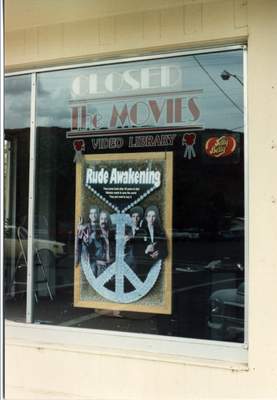 closing or sale of longtime loyal advertisers. Kyle and Carrie Bailey had supported The Z via their video rental store, “Movies of Moab,” since issue one. But when City Market expanded its inventory to include a video rental department of their own, at much lower prices, the Baileys couldn’t compete. One day I went down to their store, only to find a recent movie poster and a closed sign taped to the window. The poster was for the film “Rude Awakenings.” It was surely that, for many of us.
closing or sale of longtime loyal advertisers. Kyle and Carrie Bailey had supported The Z via their video rental store, “Movies of Moab,” since issue one. But when City Market expanded its inventory to include a video rental department of their own, at much lower prices, the Baileys couldn’t compete. One day I went down to their store, only to find a recent movie poster and a closed sign taped to the window. The poster was for the film “Rude Awakenings.” It was surely that, for many of us.
Another good case in point was Jim Sarten, the owner of North American River Expeditions. Sarten loved The Z and had been a loyal supporter for 14 years. But when he finally sold the business to a company called OARS, out of California, the ads stopped. I contacted the new company rep, who explained to me that after looking at The Zephyr and the advertising money they were spending ($59 every other month,) OARS concluded there wasn’t enough “ROI” to justify the expenditure.
I didn’t know what “ROI” meant. OARS explained it to me; it meant “Return on Investment.”
Even Pack Creek Ranch was forced to end its affiliation with The Zephyr after 17 years. Ken and Jane Sleight had been a part of The Zephyr since the beginning. But the ranch had become more difficult to operate and they had sold some of the cabins and the properties; now PCR was collectively managed by a homeowners’ association. Jane warned me the matter of ads was up to the HOA and she gave me the contact info for the spokesperson–she was in Boston—to ask about future participation in The Zephyr. The manager explained she had never heard of The Z and would have to get back to me. A few weeks later, I finally got a reply. The ads would end, she explained, because The Zephyr did not fit their marketing strategy. Again, the dreaded ROI.
To make my own situation worse, I kept turning down other potential revenue sources. For example, one of my favorite ads was for the Grand Old Ranch House. Before it became a restaurant, it had been a flop house for seasonal rangers, back in my Arches days. I’d met Ed Abbey there for the first time, prior to one of his notorious poker games where he was regularly fleeced by his good friend TK “Tom Tom” Arnold.
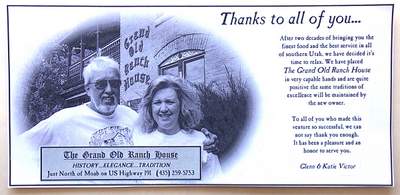
One day Glen called me up to say they’d sold the place, but that the new owner was eager to continue or even expand the ads. I asked if the place would be maintained as it was, and as it had been for the last century or so, but they were vague about his plans. “Let him explain,” they said. The Victors arranged for me to meet the new owner, McKay Edwards, a few days later.
McKay was and is a good man, but when he told me about his dream of tearing down most of the outbuildings and creating the Moab Springs Resort and condominiums, I didn’t know what to do. I had already struggled with my own ad hypocrisy on one level. But this was something new and I handled it poorly. McKay asked me to call him soon to discuss the ad and I simply failed to get back to him.
After the next issue went to press and his ad wasn’t in it, McKay called me. Awkwardly, I explained that I didn’t feel comfortable with his ad, and with the radical changes at the Grand Old Ranch House. As much as I loathed his project, I didn’t want to hurt his feelings. I’m sure I did anyway and I don’t think we ever spoke again.
And then there were the local businesses that just plain hated me and The Zephyr. Several times in the last decade, as the town’s tourist infrastructure grew faster than demand could match, some Moabites organized boycotts to kill off The Zephyr. They insisted that my “anti-growth and development” attitude was negatively impacting international travel trends.
In 2000, a group calling itself “Pro-Moab” sent a bogus letter to my advertisers. It was badly written—just the punctuation was offensive, and they didn’t even spell my name correctly—but it was an attempt to drive away the businesses that supported The Z. And, in one regard, it worked. Many of the new businesses chose not to advertise and, as I’ve already said, how could I blame them?
In reply to the letter, I wrote, “As long as humans have breathed, there have always been tragic individuals within the species who are slaves to the almighty dollar. Who fall to their knees at the sight of it. Who can NEVER satisfy their voracious appetite for it. And who hate ANYONE who isn’t similarly infected. What a wretched way to exist on this beautiful planet….Fortunately, most supporters of The Zephyr share my outlook. We like the dollar, but we’re not blinded by it. Money is a means to an end, not an egomaniacal end unto itself. We want to make a living–but NOT a killing. And we want to have a LIFE. Not just a job.”
A REPLY FROM JIM STILES TO THE “LETTER FROM FRIENDS OF THE ZEPHYR”
(“with ‘friends’ like these…”)
http://www.
BIG MONEY COMES TO THE GRA$$ROOTS GREENS…
One day, I told then-SUWA staff attorney Herb McHarg about my financial dilemma. He asked me how much SUWA was paying for its ad. “Nothing,” I said. In the ten years I had been providing space for their “Watchdog” page, I’d also given them a free ad. I thought they were in the same boat as me–poor but dedicated. Herb laughed and said, “They can definitely afford to pay for their ad.” And then some.
Until now, I had been oblivious to SUWA’s newfound wealth. For years the grassroots group had struggled to
make ends meet, but had found honor and integrity in their bare-bones operations. Now, SUWA was experiencing a sudden injection of money from billionaires like Swiss industrialist Hansjorg Wyss and multi-millionaires like Bert Fingerhut. Wyss bought them a new office building and renovated it, at a cost of more than a million dollars. Salaries jumped dramatically. Suddenly SUWA had a million dollar payroll.
I was oblivious to all this. I printed my first essay on the subject, “The Rich Weasel Factor in the New West,” in 2000, but I still hadn’t realized the extent of the influence of these mega-wealthy. And I didn’t know until my conversation with Herb McHarg that they’d infiltrated the boards of even grassroots environmental groups.
‘The Rich Weasel Factor in the New West’
The change had been dramatic. Just a couple years earlier, Groene wrote a piece for The Zephyr honoring SUWA’s former executive director, Brant Calkin. In that passionate essay, Scott wrote about money and environmentalism and his friend Brant:
“Brant offered his staff low pay but lots of autonomy to ‘do good and fight evil. The benefit of lousy pay is you get to experiment.’ Calkin offered low wages because no environmentalist should be in it for the money, and ‘pay doesn’t affect the quality of the staff.’ He offers as rationale both that environmentalists have an obligation to spend their members’ money wisely, and that small salaries ensure that only the passionate keep their jobs.”
When he wrote the piece, Scott had left SUWA , but he would later return and become its Executive Director. At the time he was critical of the growing salaries being paid out. He wrote, “Brant never asked his staff do anything he wasn’t already doing. For example, he and Susan Tixier earned a total annual salary of $20,000 between the two of them as Director and Associate Director, about a third of what the current SUWA director makes now.”
Link to BRANT CALKIN…by Scott Groene:
http://www.
Now, unknown to me, until McHarg explained it, everything had changed. Herb even offered to mention my name to one of the new SUWA benefactors. He was sure there was some way they could give The Zephyr a helping hand and channel some bucks to me. But I declined the offer. I did start sending SUWA a $144 bi-monthly bill for their ad, but within a year or two, I no longer felt comfortable with their financial support either. In February 2001, my relationship with SUWA, via its regular column and the ad, came to an end.
MY INTRO TO BONDERMAN, WYSS & FINGERHUT
Hansjorg Wyss was just one of several mega-wealthy individuals who had recently begun to play a dominant role in Utah environmental politics. In exchange for massive donations, Wyss and others secured positions on the boards of directors of SUWA, the Grand Canyon Trust and national organizations like The Wilderness Society. Another powerful contributor was Bert Fingerhut. Like Wyss, Fingerhut became a major contributor to many environmentalist groups and joined the SUWA and Grand Canyon Trust boards as well.
Here I must make a full-disclosure. In the early 2000s, as ad revenues began to decline, I looked for new ways to generate some revenue. I created the Zephyr Backbone, which allowed readers to contribute as much as $100 to the cause. In the first year, we received a check for $100 from Mr. Fingerhut. But the following year, citing financial constraints, the multi-millionaire advised he could only offer half—fifty dollars.
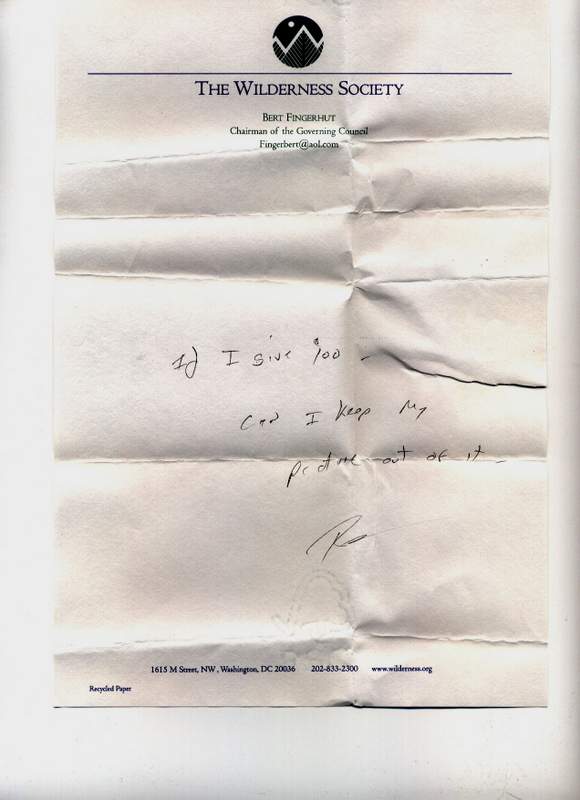
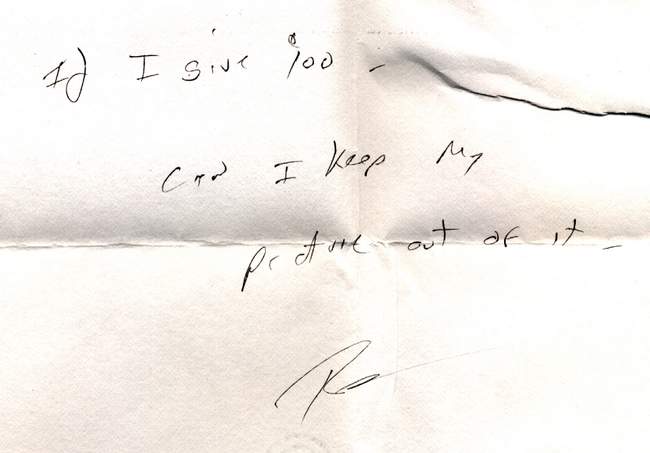 But that wasn’t the only time I profited from Mr. Fingerhut’s wealth. Years before I started The Zephyr and after I’d quit the Park Service, I was out of work and trying to make some money selling some of my drawings at the recently opened Moab Mercantile (where the Slickrock Café’ is now.) Kathy and Chuck Cooney were its owners. The only work I’d ever done of note, artistically, was my rendering of Glen Canyon Dam, blown up. It appeared on the cover of Abbey’s ‘The Journey Home,’ and I’d sold quite a few on T-shirts in the ‘80s. I still had the original and we decided to put it on the wall with a ridiculous price—$2000—with no real thought of selling it. We hoped seeing it might stimulate customers to consider the lower priced drawings. Chuck and I decided we’d raise the price by a thousand bucks every week, no matter how it went.
But that wasn’t the only time I profited from Mr. Fingerhut’s wealth. Years before I started The Zephyr and after I’d quit the Park Service, I was out of work and trying to make some money selling some of my drawings at the recently opened Moab Mercantile (where the Slickrock Café’ is now.) Kathy and Chuck Cooney were its owners. The only work I’d ever done of note, artistically, was my rendering of Glen Canyon Dam, blown up. It appeared on the cover of Abbey’s ‘The Journey Home,’ and I’d sold quite a few on T-shirts in the ‘80s. I still had the original and we decided to put it on the wall with a ridiculous price—$2000—with no real thought of selling it. We hoped seeing it might stimulate customers to consider the lower priced drawings. Chuck and I decided we’d raise the price by a thousand bucks every week, no matter how it went.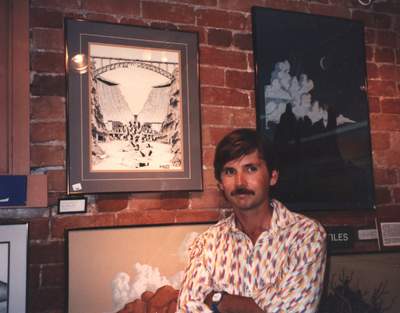
But one day, I got a call from the Cooneys; there was a man in the gallery who knew a guy, a very wealthy guy, who might be interested. I came down to meet him. He was a pleasant fellow and not rich himself, but his friend was. He said, “He wants me to try and dicker with you on price, but believe me, he can afford $2000.”
The next day, I sold my beloved ‘Glen Canyon Damn’ drawing to Bert Fingerhut. I’d never heard of him at the time, but in the years to come, I’d hear plenty.
In 2007, Fingerhut and another SUWA board member were convicted of securities fraud and went to jail. In the August 2007 issue, I wrote:
“On May 13, Bert Fingerhut pleaded guilty to one count of conspiracy to commit securities fraud. According to the Wall Street Journal, Fingerhut ‘made $12 million over the past decade by trading in the IPOs of mutual savings banks. He targeted banks that were about to go public and used the names of friends and relatives to open accounts at the banks.’ He targeted over 65 banks. He was already rich…how much more did he need?“
As part of the settlement, he agreed to return $11 million in illegally obtained profits and faces 57 to 71 months in jail. Sentencing is in September. U.S. Attorney Christopher Christie said, ‘Fingerhut used his Wall Street acumen to concoct a cunning scheme. He made millions by robbing everyday depositors of an opportunity to which they were entitled and deserved.’”
The story was barely covered in the Utah mainstream press and SUWA’s director declared that Fingerhut’s problems were not connected in any manner to SUWA. A few months later, another SUWA board member, Mark Ristow, was also indicted, convicted and sent to jail for the same crime.
SUWA’s Bert Fingerhut goes to jail
http://www.
Another SUWA board member goes to jail
http://www.
But neither Wyss nor Fingerhut could hold a candle to David Bonderman. One night I was with a SUWA board member who was still mildly sympathetic to my concerns about Wyss. He said, “Wyss isn’t a bad guy…do you know who David Bonderman is? Now THAT’s somebody to get angry about.” I learned quickly—Bonderman was/is the multi-billionaire venture capitalist and founding partner of TPG Capital. TPG invests in everything from real estate and coal-fired power plants to oil exploration to palm oil plantations around the world. But he also contributes heavily to ‘green’ groups and sits on, of course, several boards of directors. And when he first came onto my radar, he’d just turned 60 and had marked the occasion with a party in Las Vegas. For the night’s entertainment, he hired the Rolling Stones. The event set him back about $7 million. Chump change for Bondo.
In 2006, I noted Bonderman’s recent move to Moab, or at least the start of construction on a new 15,000 plus square foot home, near the Moan Sloughs, to complement his mansion and estate at Aspen. I wrote:
“Moab is about to get a new neighbor. Not long ago, I was driving down Fourth North, past the hospital and was surprised to see a crew planting pine trees along the fence line. Not a couple of trees. Or ten. And not little seedlings either. These were mature thirty foot pines and there were hundreds of them. Later I learned the number of transplanted trees, including pines and fruit trees, was closer to a thousand and that the cost of moving them was about a million dollars. And since pines aren’t native to Moab and don’t exactly thrive in its blistering heat, a couple of local truck drivers now have almost permanent jobs hauling water to keep them alive.
“The man with the trees is David Bonderman, one of the wealthiest men in America. Bonderman founded the Texas Pacific Group, a private equity firm based in Fort Worth….FORTUNE claims that in the world of private equity firms, ‘David Bonderman is as dominant as they come. He has earned a reputation as a master dealmaker, a tornado of a man spinning equal parts brilliance, energy, and charm inside his ever-moving vortex…Bonderman’s high-profile deals have given him a mystique. He’s the man who can close the sale, and his secretive style only feeds his aura. People may not see how he does it, but they see the results. The stealth isn’t just a matter of personal preference. Bonderman has learned it’s much easier to conduct business far from the prying eyes of the media, stock analysts, and the public.’
“But David Bonderman will tell you that he is an environmentalist, if donating a relatively small portion of a $6 billion fortune can make anyone an environmentalist. He has served on the boards of the Grand Canyon Trust, the Wilderness Society and the World Wildlife Fund for years. Grand Canyon Trust president Charles Wilkinson told FORTUNE that, ‘He’s one of the country’s greatest conservationists right now.’
“So welcome, Mr. Bonderman. A big Moab ‘Hello HOWDY!’ There’s always room for one more simple man of the land, here in red rock country. A living role model for all of us environmentalists.”
Some Moabites were disturbed by Bonderman’s arrival, but others, especially those financially benefitting from his frequent donations, were livid. One, the leader of a well-known grass roots group proclaimed, after reading the story, that I should be “drawn and quartered.”
In the years to come, I’d write frequently about Bonderman, Wyss and Fingerhut, but especially Bondo. Some of my readers, annoyed at my persistence, would complain, “Why do you keep picking on those three guys? There are lots of ‘rich weasels’ out there.” My answer was always the same—“Because I don’t have the time or resources to ‘pick on’ all of them.” And no one else in the media would touch the subject.
LOOKING FOR THE HUMOR IN IT ALL…
This was a very depressing time. Just a few years earlier, I had felt I was part of an honorable cause. Our motives were clear and sincere and selfless. We were working for peanuts and proud of it. I admired and appreciated my friends and was happy to be a part of something that had meaning and clarity. Now everything had changed. Now ‘saving wilderness’ was about boosting the tourist economy. Now, even grassroots groups were funded by people who, just a few years before, would hardly have been considered allies. I had become a pariah.
Still, I tried to avoid wanting to slash my wrists ALL the time, and turned to humor when I could, to alleviate the sting. I started putting together some issues that poked fun at the situation. One cover story paid biting tribute to OUTSIDE magazine’s never-ending “Top 10 Secret Cool Places” themes. Our Top 10 took a different slant that included the White Mesa uranium mill in Blanding, the Arches National Park gravel dump, and the hidden ‘Juniper Graveyard” at the Island in the Sky in Canyonlands. I wrote:
“Before the early 1980s, when the road to Grandview Point was still a narrow dirt track, the trip was dusty and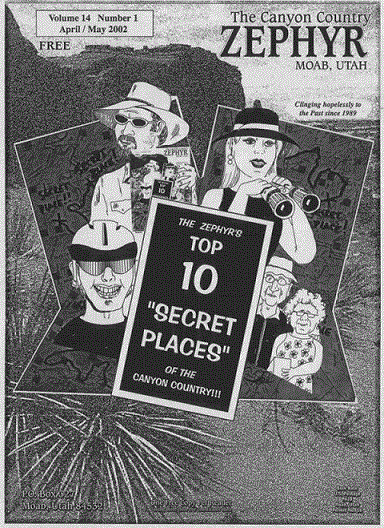 slow. One of the reasons the trip took so long was because it was rocky and rutted and you couldn’t go very fast without rattling all your teeth loose. Another reason why it took so long is because the road went around trees and followed the topography of the terrain instead of going through it (and them)…Of course, when the NPS finally and reluctantly paved the road, it took out most of the curves and leveled the dips and humps.
slow. One of the reasons the trip took so long was because it was rocky and rutted and you couldn’t go very fast without rattling all your teeth loose. Another reason why it took so long is because the road went around trees and followed the topography of the terrain instead of going through it (and them)…Of course, when the NPS finally and reluctantly paved the road, it took out most of the curves and leveled the dips and humps.
“As for all the juniper and pinyons that the new highway went through, they ended up at the end of a service road near the Green River Overlook. The Tree Graveyard used to be much larger; in fact, it covered several acres. Now, in fact, the NPS is using the same trees it killed as protective fences at overlooks to regulate pedestrian traffic! So over the last two decades, the pile has been reduced somewhat, but the graveyard still speaks volumes about modern highways and the ease of travel in the 21st Century.”
April-May 2002online issue: The Top Ten Secret Places of the Canyon Country
http://www.
Then in August, I followed up with: “FIVE NEW EXTREME SPORTS FOR THE 21ST CENTURY.” I was quite impressed with my list that included “Colonic Floss Tug-of-War, “Oral Anchor Bolt Pulling” (for all you rock climbers,) and my favorite—“Body Pierce Belaying.”…
“…Do you have body pierce rings all over your body? Have you been wondering if they have any functional value (other than the fact that they just look so gosh-darned good? Do you want to put your rings to the test? Well here’s the opportunity of a lifetime! Yes, it’s the tri-equalizing Body Pierce Belay anchor. “Brad” volunteered for this hazardous yet strangely stimulating task, because he is already adorned with two of the three anchor points that are absolutely necessary to perform this task properly and safely. The ear and nipple piercing points are real! We merely had to add a fake nose ring to perfect this extremely distasteful simulation.”
August-September 2002online issue: Five New Extreme Sports
http://www.
The off-the-wall stories caught the fancy of the footwear company TEVA; a representative contacted me, interested in running a series of full page ads. They were under the impression we were like this all the time. Yet again, I looked all that money in the eye and decided full disclosure would be necessary. I wrote back, with a fuller description of The Zephyr’s priorities and links to a few stories about the recreation industry that had previously appeared in The Z. Sad to say, I never heard from TEVA again.
GOIN’ SOUTH…
Trying to find the absurdity in all this, I vainly attempted to convince myself that if I could just look at the dramatic impacts and the changes in geologic time, the upheaval wouldn’t seem nearly as catastrophic. But there’s little comfort in geologic time. What I was watching was the transformation of my home. Finally, one day in August 2002, feeling especially desperate, I decided to leave town.
I was passing through Monticello, 55 miles south of Moab, and a chip-seal project on Main Street diverted me east a few blocks. A ‘For Sale’ sign in the front yard of a tiny, tree-lined cottage caught my eye. It was offered by Lex Realty and I stopped by the office to learn more about it. Bennion Redd, a lifetime resident of Monticello and one of the most decent men I’ve ever met, told me that the house was owned by his sister and brother-in-law; Doyle and Marilyn came down to the office and we dickered on the price for about a minute. We shook hands and Bennion said he’d do the paperwork and we’d close in about a month.
I told very few people about the move, and those I told were incredulous—“Moving to Monticello? The Mormons will eat you alive!”
But almost everyone else was oblivious to my frequent back and forth trips to Monticello, as I transferred my life from Grand to San Juan County. I discovered, to my great relief, that while Monticello was close to 90% LDS, I was treated fairly and kindly by almost everyone in town. I may have been a Gentile and a heathen in the eyes of some Monticelloans, but at the very least, most of them seemed inclined to give me the benefit of the doubt. And I enjoyed the peace and quiet, though the bitter cold winters that began in September and lasted through May were sometimes hard to take.
But even if if I’d been stoned by the residents, just getting to be the neighbor and friend of Gene Schafer made the move worthwhile. Gene was a whisky-sipping, non-Mormon auto mechanic who was….how do I put this…outspoken? I wrote a piece about the legendary Schafer and made this observation about my dear friend:
“He’s the most honest man I’ve ever known, which causes both chuckles, frowns and a squirm or two from a broad range of friends and adversaries. He grew up a Gentile in a community that is 90% Mormon; yet he has earned the respect of practically everyone, regardless of religion, because in the end, Gene Schafer is a straight-shooter. He never tries to be anyone but himself, and in this godawful time of political correctness and pained pretension, just his ‘tell-it-like-it-is’ approach to life makes him a unique and unforgettable man. He once told San Juan County’s most celebrated curmudgeon/misanthrope that he, ‘crapped too close to the house,’ and not only lived to tell the tale, he made the guy laugh.”
The link to: “Only Schafer Can Get Away With That.”
http://www.
Gene contained multitudes. He could be pretty abrasive and spoke his mind a lot more than some people would have preferred, but his kindness and generosity never had conditions attached. He didn’t do good deeds because he wanted to be known as the guy who did good deeds; it’s simply who he was. Once, when I had hit rock bottom and was drinking way too much vodka and downing way too many valiums, Gene came by to check on me. I staggered to the door, Gene took one look at me and said, “Damn Stiles…You look like shit.” He shook his head, assessing my pathetic state and added, “I’m gonna go get you some steaks.”
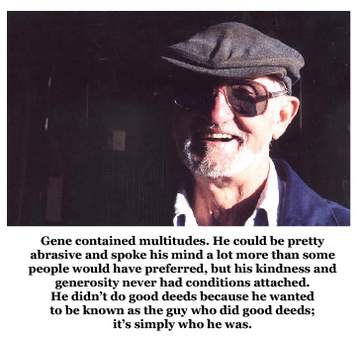
THE GREENING OF WILDERNESS…part 1
In April 2001, I had first suggested that the environmental movement and its embrace of a tourist/recreation economy was creating impacts of their own, that most of us were unwilling to address. “It’s Time to Look in the Mirror” was a seminal moment for me and this publication.
It’s Time to Look in the Mirror: http://www.
Now, four years later, I was ready to take the debate a step farther, though the ‘other side’ did its best to simply ignore the questions. “The Greening of Wilderness” was one of the most difficult stories I ever wrote. Much of it would appear in a book I would write called “Brave New West.” (More about that effort later.)
“When I first sat down to write the very long and difficult story that begins on page 12 of this issue, it was more than three years ago. The themes raised in this story have been nagging at me for even longer than that — I made my first attempt to discuss the changing urban west and environmentalists’ shifting strategies in April 2001 with the ‘It’s Time to Look in the Mirror’ edition. It received an extraordinary amount of feedback, the most in this publication’s history, from a wide variety of readers. What it did not generate was any response whatsoever from the organizations in the environmental community for which it was mostly intended. Since then, any attempt to discuss the concerns raised in that article have been met for the most part with, at best, stony silence and at worst, downright hostility.“
The reason I delayed this story for so long is that I was angry too. Writing from a position of personal hostility is not the most effective way to deal with problems, though I freely admit that I have been guilty of typing with angry fingers from time to time. It was hard to accept that after two decades of being a friend and partner to most enviro groups in Utah, I found myself cast as something of a traitor and even a pariah, simply for asking what I thought were honest, if also difficult, questions.”
THE GREENING OF WILDERNESS: http://www.
The long cover story addressed the history of wilderness in Utah, and attempted to explain how the strategies to preserve it had changed over the years. I concluded:
‘How can environmentalists escape the label of hypocrisy? How can we condemn oil exploration when our own consumption of oil is staggering? How can we condemn the impacts of motorized recreation while we turn a blind eye to the damage caused by ever-growing numbers of non-motorized recreationists? How can we heed Abbey’s warning of Industrial Tourism when, at its heart, that kind of economy is the future many enviros have embraced for 15 years? How can we condemn the timber industry when we continue to build homes at an alarming rate that encroach on the habitat of the very wildlife we want to protect, and then construct them far bigger than anything we’d ever need to be happy? And when some of our biggest environmental contributors consume massive amounts of natural resources to build monstrous part-time homes, how can we possibly accept their donations?
“Like a civil rights organization in the 1960s accepting money from a man who belonged to an all white country club—these are the contradictions that destroy our credibility. And like the Civil Rights Movement of 40 years ago, saving what’s left of the wild American West is a moral issue, first and foremost. We didn’t fight for the rights of African-American men and women because there was a dollar to be made. Nor should that be our motivation as environmentalists to save wilderness. If we continue to follow this dangerous path, we may some day wonder if the Road to Victory was worth it…Or wonder what it is we actually “won.”’
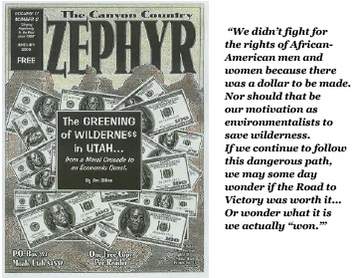
The response was unprecedented. Our Feedback page was tripled to accommodate the letters and most of them were supportive. One couple, Sierra Clubbers, briefly accused me of fabricating a letter they sent to the controversial Cloudrock developer Michael Liss–a letter I had published in full in the ‘Greening’ article. When I produced the originals, they withdrew their complaint and wanted the matter dropped, but since I’d never been accused of lying in the Zephyr before, I chose to print their original letter anyway. All of the correspondence is included below:
http://www.
SUWA had long since quit corresponding. In one last heated argument with Scott Groene, after he’d once again accused me of having an “anti-SUWA tirade,” I got pretty upset and wrote in part:
“It isn’t “anti-SUWA tirades.” My god, you just don’t get it. I just want them to broaden their vision beyond cows and oil and jeeps. I remember you said ten years ago that it would ‘really get tough when we have to fight our friends.’ We don’t have to fight them, just be able to speak honestly, and let the chips fall where they may. There’s nothing courageous about being an enviro and standing up against oil wells. Anybody pc moron can do that. The fact that you won’t even tell me where you stand on the topic is extraordinary. Why would an honest answer be “trashing (your) friends.”?
“Environmentalists are supposed to be visionary. We’re trying to play a role in the future, beyond our own personal involvement in it. If we allow ourselves to ignore threats to that future, based on the fear of insulting a friend, then I think there’s a problem…Anyway, I’m really disappointed that you can’t discuss these issues without feeling like you’re betraying friends. How shaky can these friendships be, if speaking candidly and honestly constitutes a betrayal?”
THE HIGH COUNTRY NEWS ‘CURMUDGEON’ STORY
In 2006, writer John Fayhee wrote a cover story about The Zephyr and me for High Country News. While John sometimes revealed more about my personal life than I felt comfortable with, it was a fair piece. Best of all, he
had taken the time to come to Moab and talk. In fact, we spent several days together, sometimes camped out (illegally) at a favorite Arches spot, and sharing a few adult beverages. In this regard, I feared I’d disappoint the author, as it was a well-known fact, then and now, that Mr. Fayhee appreciates a good libation. Still, he was one of the few who at least seemed to ‘get’ where I was coming from. He may not have agreed with my beliefs, but it meant a lot to me that he at least took the time to hear what they were.
John traced the history of The Zephyr, back to its 1989 origins, and the changes that occurred along the way. John wrote:
“This would be a good place to stress that no one, not even Stiles, is accusing the environmental movement of premeditation in fomenting the amenities-based ruination of the West. Stiles knows as well as anyone that a host of forces have conspired to create this beast, from the global economics that torpedoed Southern Utah’s uranium mining industry, to the Baby Boom’s mass retirement, which is sending us a tsunami of second-home buyers. Nor is Stiles an apologist for the extractive industries; he feels there’s a special place in hell for many ranchers and miners.
“But Stiles does believe that the amenities economy that defines so many “New West” towns is as harmful to the environment as the extractive industries were. He contends that the environmental movement helped usher in that economy as an alternative to mining, timbering and ranching. And he says that the environmental movement can’t come out and lambaste the New West economy, even if it wants to, because it is so invested in the argument that wilderness is the perfect economic engine for rural towns.”
Fayhee pursued the matter with my old friends at SUWA who had little if anything positive to say about the publication they once called “The greatest newspaper in the world. Then-staff attorney Heidi McIntosh noted that, “At one time, The Zephyr was important.” She explained, “I can’t even read The Zephyr anymore…It’s not relevant.”
Fayhee continued,“From the sidelines, it would be easy to dismiss all this as a family squabble, one that, for all we know, has roots in a softball game argument 20 years ago. SUWA has done its best to dismiss Stiles’ writings as the product of an angry, even unstable man. ‘It’s like he’s angry about something deeper and taking it out on us,’ says McIntosh, SUWA’s conservation director.
“But that explanation cheapens Stiles’ real point, which Groene ignored in the Tribune. That point is that SUWA does little to fight the threats that the New West economy poses to the Canyon Country. Instead, it pours its substantial resources into the decades-old fight to protect huge gobs of wilderness — a fight that, in Stiles’ estimation, has gotten nowhere.”
When the long story finally appeared, in May 2006,, my fall from grace, in SUWA’s eyes, was a fait accompli.
For the link to Fayhee’s story: http://www.hcn.org/issues/323/
The idea that Heidi McIntosh could make those kinds of personal observations about my mental state were downright bewildering to me, since, in fact, we’d never met. I wouldn’t know Ms. McIntosh if I fell over her. And while I’ve had my dark times for sure, I was feeling particularly magnanimous when the story came out, so I wrote to Heidi, via email on June 2, 2006. The subject line read: “A sincere offer.”
I wrote, “I finally read the HCN article and your observations; unless I’m mistaken, I can’t recall that we’ve ever met. And if you don’t read The Zephyr anymore, it could be that your opinions of me and the Z are second hand, at the very least.
“I’ve been arguing for years that the main reason America is so polarized these days is because we don’t talk to each other—that we all base our opinions on perceptions more than reality. I’d like to make an offer here. How about coffee or lunch sometime, either the next time I’m in SLC, or when you’re down here? We could put aside contentious issues for another time and make the goal of this meeting just to get acquainted, and to show each other that neither wears horns or a straitjacket. I’m absolutely sincere in this and hope we can find some common ground.”
I waited and waited. I still am, in fact. I never heard back from Heidi.
If there was one disappointment in the story, it was a concern shared by both Fayhee and myself. HCN’s decision to describe me in the cover story title as, “The Canyon Country Curmudgeon” was, we felt, an effort to marginalize me as some kind of anachronistic old grump. And in publisher Paul Larmer’s page 2 introduction to the story, he curiously gave Grand Canyon Trust executive director Bill Hedden the last word of sorts. “Our resilient community leaders,” Hedden had written, “got in their row boat and went fishing for a little tourism to revive and diversify our economy. They hooked a great white shark.” But the quote was from 1994. Few in the environmental community had come close to expressing such concern in years. I was puzzled at the time, but later I would understand Hedden’s last minute inclusion.
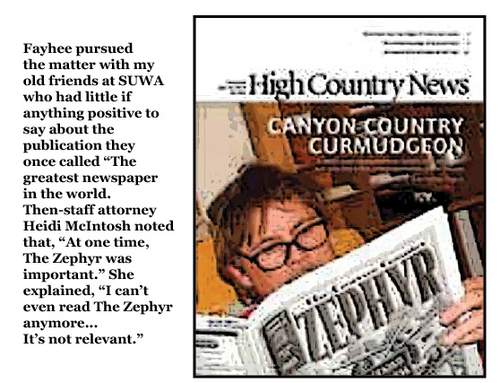
Still, Larmer noted, “Of course, if my kids’ nostalgia is any indication, today’s great white shark will seem like tomorrow’s bluegill. In a few years, we may look fondly back at the good old days when you could still buy a house in Moab for $300,000, when a mere 50,000 mountain bikers attended the Fat Tire rally, and when you only had to book a camping spot in Arches a year or two in advance…If we’re lucky, though, we’ll still have curmudgeons like Stiles around to keep us on our toes, and to remind us what it is we love about the West.”
Link to Larmer’s introduction: “Nostalgia is a Moving Target:” http://www.hcn.org/issues/323/
THE ‘SUWA CAN YOU SPARE A DIME’ INCIDENT
At about the same time Fayhee was writing the HCN story, I’d submitted a short essay to HCN’s syndicated “Writers on the Range,” called “SUWA Can You Spare a Dime?”
For the link to that story: http://www.hcn.org/wotr/16196/
While my essay noted that, “SUWA remains Utah’s most vigilant watchdog of off-road vehicle abuse, oil and gas exploration and public lands grazing,” I was critical of their failure to address environmental impacts from the booming recreation economy. I proposed that, with its $5 million in net assets, SUWA could share some of its largesse with smaller green groups that were not so flush with funds.
When the story ran in the Salt Lake Tribune, Groene demanded rebuttal space from Betsy Marston, the Writers on the Range editor. But when it arrived, she found the article so steeped in anger and vitriol that she asked Groene to remove them; she advised him to re-write his essay, without the nasty stuff, and re-submit. But he never did. Instead, he found a sympathetic editor at the Salt Lake Trib who would print the story “as is.” It was a doozey. In part, Groene wrote:
“Part of desert country’s magic is that it nourishes eccentricity,” Groene explained. ” Jim is part of that, our own Barney Fife. He’s worth having around though, even if we have to clean up after him now and again. “Typically enough, Jim’s rant says less about SUWA than about Jim’s own curious little world. As its only resident, he’s in charge. He gets not only his own opinion but his own facts.”
The Trib gave me a few lines to respond in its “Letters” section. “Now that I have had the gall,” I wrote, “to disagree with some of SUWA’s strategies and to suggest that it might want to share even a fraction of its $5 million bankroll with other enviro groups, I appear to be in the doghouse. And with Barney Fife no less.” More importantly, I recalled the words of Edward R. Murrow, who wrote, “ ‘We must not confuse dissent with disloyalty. When the loyal opposition dies, I think the soul of America dies with it.”
But there was no comment from SUWA and I wondered what its board members thought, so I sent an email to those I could reach by email, including Ted Wilson, the vice chair with CCs, Rich Ingebretsen, Terry Tempest Williams, and Bill Hedden. I only heard from two of them. Wilson sent a short and conciliatory note. Hedden responded at length. It would be the first of several combative and contentious exchanges over the next two years. While he thought Groene’s comments were “unproductive,” he believed my concerns could be de-bunked via pure logic. He said my ideas were “wacky,” and even seemed to take offense at Herb Ringer’s photographs in The Zephyr.
“In all your years of publishing the Zephyr and commenting on these issues,” Hedden complained, “you haven’t made any suggestions about how to solve the problem…how could you? what would they be? Appoint a benevolent dictator? Publishing Herb Ringer’s photos isn’t going to bring us back to some prelapsarian paradise.”
I confess I didn’t know what “prelapsarian” meant and had to look it up. Hedden continued, “One reason that it has been hard to start a dialogue on this issue of the changing West is that nobody, including you, has anything constructive to say about it. People tried to politely look the other way when you decided to circle the wagons and fire inward, but Scott finally shot back.” Clearly, nothing, not a single word or question I’d raised in the past five years, in Hedden’s estimation, had carried a scintilla of credibility. My criticisms had been reduced, yet again, in his mind, to an angry and meaningless rant.
Bill insisted that environmentalists had, in fact, worked tirelessly to deal with the effects of the tourist/recreation industry. He said, “Turning to your assertion that nobody has acknowledged that there are New West impacts…I’m just puzzled. I have spoken about that earlier and more publicly than most others, and spent my time as a councilman working to help Grand County try to set policy on the basis of what was good for the people who live here rather than the desires of the tourist economy.”
And yet, three years earlier, in a 2003 Zephyr interview with Ken Davey, Hedden seemed ready to throw in the towel. He told Davey, “We’ve had some of the most spectacular country in the world, and no one else in it. The fact that those days are just about over is sad, but there are many more people in the world, and they have found this place, and there’s no keeping them away. Just regulating the wild places and putting in porta potties and hardening campsites and paving trails may deal with the impacts, but it doesn’t help someone who knew that canyon when it was wild and no one else was in it. That’s what I mean by the problem being insoluble.”
I finally responded, “Consider the fact that, even through all this, with you challenging my honesty and Heidi McIntosh, who I’ve never even met, performing public dime-store psychological analyses of my character, and Groene’s in-print temper tantrum, I have never attacked you or your character personally, or anyone’s at SUWA—all I’ve ever done is raise honest and legitimate questions about the tactics and strategies of the environmental community. That’s all I did. You may not think they’re legitimate but clearly, others do.”
Bill’s reply fell back on the same familiar old line, “Funny, you seem awfully angry.” Once again, I was the angry man, just for trying to be honest.
The same night that Hedden’s email burned through to my inbox, Fayhee called me about his High Country News story. He had a list of possible interviews and Hedden was among them. I chuckled and said, “That should be interesting. I just got a zinger of an email from Bill…It’s still smoking”
Fayhee asked if he could read it and I could find no reason to say no. My letter to the board of SUWA was not a personal correspondence. I had sought their comments for publication and, in fact, Hedden had merely been a “cc” recipient.
“Sure. Why not,” I said.
Later, when I sent yet another apparently annoying email, Hedden was furious. By sheer chance he’d met Fayhee at a bar, the emails had come up, and Hedden felt violated (probably he does again now.) He angrily wrote, “I responded to you as a fellow member of my community whom I have known a little for a long time. Had I known that you planned to send some unspecified portion of our exchange off to newspapers, I would not have communicated with you. I don’t publish a newspaper and I don’t write op-eds bashing people, so your notion of a free and honest exchange of ideas is unfair.”
I replied, “Bill…our emails were not private conversations…my comments and questions were addressed to SUWA board members. I was trying to find out where you people stand on some of these issues that you have all taken cover from for so long….The emails had nothing to do with our private lives. Anything we discuss related to environmental issues should be part of the free and open exchange of ideas that I’ve advocated for so long. As long as it doesn’t get nasty or personal, how does it hurt to share your opinions with other people? And so far, the mud that’s been slung seems to be coming from ‘your side.'”
Again, there was no ‘bashing,’ unless the word means expressing disagreement. I agreed that Hedden’s reply to my email had indeed made the conversation personal. He’d even questioned the value of my dear friend Herb Ringer’s contributions. How could anyone NOT at least find pleasure in looking at Herb’s old photographs?
And I advised him that he was free to share my end of any correspondence that had ever passed between us, with anybody of his choosing. I try to never say anything that I would be ashamed for others to hear. And after all, these emails were NOT of a personal nature. It was me, as a journalist writing to the board members of an environmental organization. But Hedden didn’t see it that way and thought I was unprofessional. My apparently fatal character flaw was my willingness to be open and uncensored.
And when world class ego-climber Dean Potter made the first solo/self-promoted climb of Delicate Arch, I again asked for comments from the environmental community. Would any of them speak up? I wondered if this was still the kind of non-motorized recreation that environmental groups think represents a huge wilderness advocacy group. I hoped that maybe it was finally sinking in—that these kinds of exploits have nothing to do with wildland protection.
In response to a heretical notion (I suggested a short press release from environmental groups, condemning that kind of outdoor behavior,) SUWA board member Bill Hedden replied in part: “He was an asshole to climb Delicate Arch and I would have arrested him happily if I was a ranger… But, if you got there five minutes after his desecration, there would have been no visible trace. So, should the enviros, who really are just a few people, prioritize going after him instead of dealing with the largest oil and gas lease sale in Utah history, or the fact that Norton’s parting gift was to declare that all the county road claims everywhere are valid, or Bennett’s proposal, or Hatch’s separate one, to sell off large blocks of public land to provide funding for water pipelines and roads and utility corridors?”
Of course I didn’t suggest they abandon any of that. And Hedden knew it. What I proposed was “a three sentence press release.” What I was suggesting, even to the point of reiterating Hedden’s own words was that, “Industrial-strength recreation holds more potential to disrupt natural processes on a broad scale than just about anything else.” I thought that maybe he and others might finally want to speak out against the entire ‘disrupting’ impact of out-of-control recreation, and acknowledge that the tourist/amenities economy brought destructive impacts as well; that it was a serious component when one measured the long-term threats to the landscape of the American West. I thought such recognition might be a turning point and a new beginning for Utah’s mainstream greens.
But those words from Bill Hedden had come in a different time.
(NOTE: Eight years later, as extreme sports become an even greater intrusion on public lands and wilderness, and as the impact from new “sports,” like BASE jumping and arch swinging make national headlines, environmental groups in Utah continue to maintain a predictable silence. Currently, BASE jumper/stunt performer Sketchy Andy Lewis faces charges at Arches National Park; yet, Lewis might want to call Hedden as a witness for the defense. As Hedden noted regarding Potter’s Delicate Arch climb, “if you got there five minutes after his desecration, there would have been no visible trace.” Sketchy Andy may have allies in unexpected places)
A DEATH IN THE FAMILY…
In late October 2006, I was headed home from Tooele, where we printed The Zephyr, with a truck load of new papers and was stuck in a godawful traffic jam near Price on US 6/50. I called my best friend, former County Attorney Bill Benge, to tell him I’d be late. Lately, Bill had been helping me unload the huge pile of 15,000 Zephyrs from my ancient truck to my front porch, though the last time, he’d lent a hand, I’d been worried about his blueish color and lost breath. “It’s good for me, “ he’d wink. “You know how much I love exercise.” Now I told him we’d just wait until the weekend to unload.
Bill had been an integral part of The Zephyr since Day 1…since before Day 1, in fact. Going back to the winter
of 1988-89, as the idea of The Zephyr began to grow, my greatest handicap was a lack of money (what else is new?). How would I afford the computers and printers we’d need to make it work? Bill had graciously offered his own, letting me use it after hours. And he’d become a regular contributor with his “Willie Flocko’s Country Kitchen.”
But on that October afternoon, as I fumed in traffic, he warned me to take it easy. “Life is short, Stiles….Don’t blow a fuse over nothing.” It was good advice and the last time I’d hear his voice. On Friday evening, October 20, Bill had gone to a party at the Back of Beyond Book Store. Headed home, he stopped at City Market to grab a few snacks. Standing in the checkout line, Bill suddenly grabbed his chest and without a word, fell to the floor. He died almost instantly. Earlier that summer, he had complained about a numbness in his arms and throat, and one day sharing breakfast together at the Moab Diner, he’d almost passed out from the pain. He was scheduled to see a doctor in November. Now my old friend was gone.
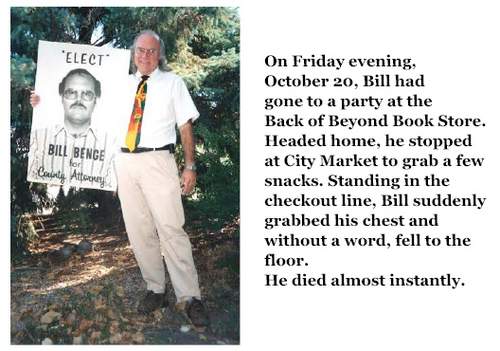
It always sounds so trite to say it, but Bill was like a brother to me. We argued, had fallings-out, made up, shared our darkest thoughts and our highest hopes and dreams…the way brothers do. He saved my life once—really; and there was a time when I was able to re-pay the debt.
In the last year of Bill’s life, we spent a significant amount of our time together reminiscing and lamenting the changes that had transformed Moab in the last decade. We were very good at it. It had been, for years, a quiet, albeit oddly diverse little community; now, as we all know, in little more than a decade, Moab had become just another New West real estate market to be exploited and sold off in quarter-acre parcels. We barely recognized our old town anymore.
We often had breakfast at the Moab Diner, one of the few cafes left in Moab that didn’t exist merely for the tourist traffic. That is to say, it was still affordable and the waitresses recognized us. On one of our last trips to the diner, however, we found our café so crammed with strange faces that we had to take a number and wait for a table. It wasn’t the Diner’s fault—it had simply been overwhelmed by its own success. But Bill turned to me and said, “It’s over, Stiles.”
The day Bill was buried, his will was discovered and I learned that he’d named me the executor of his estate. I spent the next 18 months immersed in the artifacts of Bill’s life. It was one of the most bittersweet times, as I came upon one ‘Willie Flocko’ reminder after another, I’d find myself smiling at the memory, but grieving that those days were gone. After Bill left us, Moab, for me, was never the same.
Link to “Bill Benge, Old Friend”
http://www.
BRAVE NEW WEST…THE BOOK &…THE MOVIE?
Back in 2003, the University of Arizona Press contacted me about doing a book. At the time, I doubted my ability to complete the project, but a year later, they asked again and I decided to give it a try. The project dragged on for years. I sent them a proposal; the submissions editor sent it to her advisory group for review; while one reviewer feared the book might become little more than an anti- mountain bike rant, enthusiasm was still high. But somehow the proposal was set aside and misplaced and languished in a box for months. When I jogged editor’s memory, I was sent a contract inside a week.
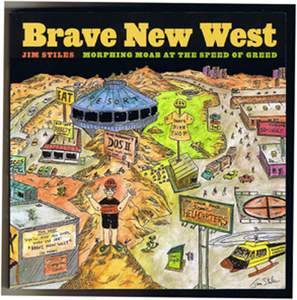 I wrote the book in a year and submitted it by the August 1, 2005 deadline to assure it would be published by October 2006. But the manuscript sat a while longer and finally, when ‘Brave New West: Morphing Moab at the Speed of Greed” was finally published in the Spring of 2007, the book was already outdated. I could have filled another book and updated much of the information that BNW contained. Much of the background to BNW would have stayed the same, but as the ‘New West’ exerted its influence at an ever increasing and alarming rate, the last half of the book was already outdated. At least the theme was still current and I made the best of it.
I wrote the book in a year and submitted it by the August 1, 2005 deadline to assure it would be published by October 2006. But the manuscript sat a while longer and finally, when ‘Brave New West: Morphing Moab at the Speed of Greed” was finally published in the Spring of 2007, the book was already outdated. I could have filled another book and updated much of the information that BNW contained. Much of the background to BNW would have stayed the same, but as the ‘New West’ exerted its influence at an ever increasing and alarming rate, the last half of the book was already outdated. At least the theme was still current and I made the best of it.
I knew from the get-go that university presses rarely have the financial resources to promote a book the way they’d like to, and I have never been much of a self-promoter either. The University of Arizona Press set up readings in Moab at Back of Beyond and at Ken Sanders Books in Salt Lake City. UAP set up an interview with KCPW public radio in Park City and attempted the same with KUER, but we never heard back from the latter. In Salt Lake we had a great turnout. My old friend Ken Sleight came up from Moab to introduce me, and since my fear of public speaking borders on phobia, Ken was there to catch me if I passed out. Fortunately I survived the evening. The event in Moab was also a great success, but when it came to me scheduling events of my own, I was a miserable failure. And when we did manage to gather a group—we had readings in Grand Junction, Springdale, Utah and Torrey, Utah—the organizers had trouble obtaining copies for BNW for me to sign. Not having books to sign at a book signing was not an optimal situation.
The ‘Salt Lake Tribune’ did a story on the book, but even that experience was a mixed bag. I received a call from Trib reporter Anne Wilson (no relation to Moab’s AW). I met her at the Moab Diner and she introduced herself by saying, “I’m the food editor at the Trib, I haven’t read your book and I’ve never heard of The Zephyr…But here I am.” It was an inauspicious beginning.
But Anne seemed like a nice person and I did my best over the next few days to explain ‘The Zephyr’ and the ‘Brave New West.’ We traveled to Arches with photographer Ramin Rahimian for pictures and we almost got arrested by a ranger for not having a film permit. Fortunately an old friend and NPS staffer Anne Corson intervened on our behalf (Though my recollection is that she first instructed the ranger to arrest us.)
I had some good chats with Ms. Wilson and on our last day, we went to lunch at the MD Ranch House. Over a burger and fries, Wilson smiled and confessed, “You know, you’re nothing like what my editor told me to expect.”
“Really? I said. “…how am I?”
“I like you a lot,” she exclaimed. “And you’re even funny.”
I was taken aback. “Well…what did your editor say I was like?” I asked.
Anne replied, “He said you would be very difficult and that you are a hermit nutcase.”
A hermit nut case? I had to wonder if this was the same editor who’d been so receptive to Scott Groene’s ‘Stiles as Barney Fife’ essay, but I never discovered his identity.
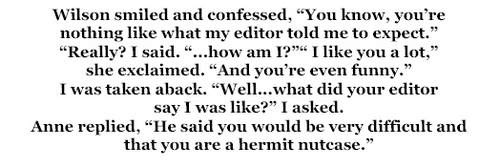
When the story came out, the editors distilled everything I’d talked about and the entire content of the book into the headline: “Activist Says Adventurers are Ruining Moab.” The rest of the story did a fairly decent job of recounting my fears about the changing West and that mountain bikes and adventure tours were merely symptomatic of a recreation culture that was creating its own kinds of impacts. And yet, my passing references to departed friends Herb Ringer and Bill Benge seemed to assume more column inches than I would have expected. The fact that I was still spreading Herb’s ashes and still had some of Bill’s gumbo in my fridge made me sound like some kind of a ghoul who collected artifacts of the dead. But as my friend Ken Sanders advised, “Never complain about a front page story, even if it’s bad and even if it’s below the fold.”
Elsewhere, the reviews were good, though High Country News chose a 27 year old mountain biker to offer an opinion about ‘Brave New West,’ and the author penned an opinion called, “You Ain’t From Around Here, Are You?” He depicted me as some kind of shit-kicking redneck who didn’t take kindly to uppity newcomers.
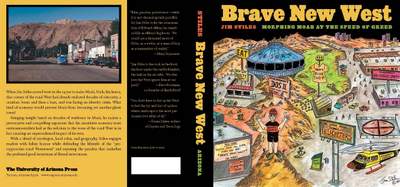
‘Brave New West’ sold out its first press run in 2010, but I received a letter from UAP, explaining that because of the complexity and cost of re-printing a book with so many illustrations, thy would be unable to do a second run. The book is now out-of-print, except for the 100 copies I still own and distribute to new members of The Zephyr Backbone. I’ve thought of approaching other publishers to put BNW in print, and maybe propose a sequel, but sloth and a total lack of ambition has kept me from doing so.
THE MOVIE…
A year before ‘Brave New West’ was published, I got a call from a documentary filmmaker Dru Carr. He and Doug Hawes-Davis owned a production company in Montana called High Plains Films and had recently learned about The Zephyr from occasional contributor Ned Mudd. They were interested in coming to Utah and pursuing the idea of a short film about my little rag. We met in the spring on 2006 and for the next year or more, they were frequent visitors. Doug and Dru are salt of the earth guys and I enjoyed my time with them, so sometimes I grew weary of being ‘wired’ all the time. One day we went to Moab to visit a few of my favorite hangouts. I was having a bagel with my old pal Bill Koci, and Doug and Dru wanted some shots of us walking down Main Street. I was in an especially grumpy mood that day and as Bill and I did our performance walk, Bill said, “Who are these guys anyway?” I snapped, “They’ve been following me around for months. It’s driving me crazy.” When we turned around and made our way back to the camera, Dru grinned and said, “You know, your mic is hot. WE can hear everything you’re saying.” Never had I felt so mortified.
“Brave New West,” the film, came out in 2008. It aired at festivals around the country and eventually appeared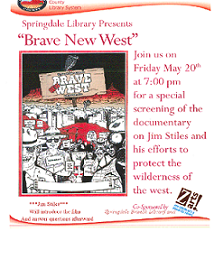 on public television channels across the country, but I don’t think it ever aired on the PPS station in Salt Lake City, KUED.
on public television channels across the country, but I don’t think it ever aired on the PPS station in Salt Lake City, KUED.
Here’s the link to the film:
http://www.highplainsfilms.
AND FINALLY…THE AUSSIE EXPERIMENT, AN UNEXPECTED ANNOUNCEMENT & THE GREENING OF WILDERNESS 2
By 2008, the inevitable seemed unavoidable. The Zephyr was no longer a Moab-based newspaper. Main Street businesses were dominated by “Adventure” signs. I didn’t know the businesses and I didn’t know the people who owned them. They were now Moabites and the future of the community would belong to them. My ads declined further; in fact, after about 2007, I even quit looking for new revenue sources. There was something liberating in all this. I had been working for a year on a sequel to my 2005 “Greening of Wilderne$$” story. “Greening 2″ appeared in the August/September 2008 issue. To give you an idea how little I was concerned with being anything but candid, the introduction to the cover story was called,
ON THE RECORD? OFF THE RECORD? POLITICALLY CORRECT? POLITICALLY INCORRECT? I SAY, “SCREW IT.”
I wrote,“When I started the Zephyr, I had to make a choice that I didn’t even realize when I made it. I could either be honest (to my own values at least), even painfully blunt, or I could try to be liked. My ornery personality probably made that decision for me.
“Over the years, as a result, I collected more than any man’s fair share of enemies and adversaries, especially in Moab. But I came to appreciate the opposition, if they would just express themselves as openly and honestly as I challenged their perspectives.”
“This is no ordinary time. A few weeks ago, the Associated Press ran a story called, ‘Everything Seemingly is Spinning Out of Control.’ From natural disasters to the price of airfares, the falling dollar, the rising cost of gas, the sports scandals, global warming, wars—where do we go to feel better about anything? Or should we? Is it Reality Time, at long last? The AP story concludes, ‘…maybe this is what the 21st century will be about —— a great unraveling of some things long taken for granted.’
“Old solutions don’t work anymore and thinking, in this day and age, that the end somehow justifies the means, no matter how corrupt or counter-productive those means might be, does not stand. That is why the cover story to this issue is one of the most important this publication has ever published. ‘The Greening of Wilderne$$…part 2: How the Mega-Rich are Co-opting Environmentalism and Turning IT into a Big Business,’ is the sequel to Part One, which first appeared in the June/July 2005 issue and which wound up in ‘Brave New West.’ It is incredibly long, almost 10,000 words, and I urge you to read it slowly and thoroughly. It is also well-documented. The web links that I used to compile the story are listed at the end and the quotes therein comprise more than half the story’s text. I will be curious to see the response, if any, from the mainstream environmental community. If the past is any indication, I should not hold my breath.”
August – September 2008 online issue: The Greening of the Wilderness Part 2
http://www.
and the re-posted version on the ZBlog:
http://www.
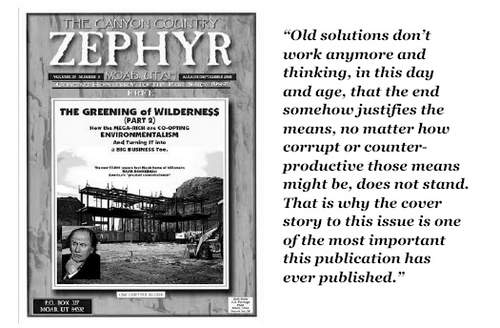
The long article was as well-documented and carefully written as any writing project I’d ever taken on. The response from my readers was gratifying; I wasn’t sure anyone would wade through a story that long. Our Feedback page was expanded to accommodate the readers. Legendary river runner/singer/author Katie Lee wrote, “What an utterly fantastic job of journalism. How many hours you must have spent on the research alone would be uncountable!… I’ve sent it on to many folks I know who won’t get the Zephyr–probably the rest of the choir, but it’s something everyone should read, whether they’re on your side or not.”
Utah author Stephen Trimble offered a more measured response, believing that environmentalists could accept large donations under certain circumstances. “I think the ideal would be for the conservation organizations to be led by fiercely independent, stubborn, and charismatic people who fight the good fight unapologetically–while gratefully accepting money from the wealthy board members who support them and who have their own reasons for donating. Maybe this is too much to ask for, maybe not. Those wealthy people do need the write-offs. And they must care about the goals (or their image) to associate themselves with the enviros…But,” he noted, “it takes courage and unassailable integrity. The more money the enviro leaders make, the more they become part of the inner circle of power–and the less likely they can be effective revolutionaries….Thanks for your own journalistic courage…”
And just for form’s sake, I sent a link to 25 Utah environmentalists, but I advised them, “The Zephyr welcomes your comments but will regard any submitted as ‘on the record..’”
Only the Grand Canyon Trust, again via Bill Hedden, replied, with a short list of “corrections.” I printed his comments and my response in the October issue:
FEEDBACK: http://www.
And while I had warned everyone that any comment submitted would be ‘on the record,’ his email named board members and other details that I had not pursued, then admonished me not to print them…“Unless you are as vindictive as you seem to be (for what offense I do not know), you will still not publicize it in the paper…As you know, I shared your ideas about the problems of industrial recreation from the beginning, but I am still waiting for you to tell anybody what to do about the problem. We are a small community of people trying to deal with a great many problems and we have to choose where our efforts might actually bear some fruit. You are back to the population problem, and no environmental group around is set up to deal with that one.”
And it was once true; a decade earlier, Hedden had noted that, “Industrial-strength recreation holds more potential to disrupt natural processes on a broad scale than just about anything else.” But neither he nor the GCT nor any other green groups had even remotely dealt with the issue in years.
I wrote to Hedden, “I think it’s more than population. I think it’s an expanding population coupled with runaway consumption. And now the whole world is infected with this Madness. What Wendell Berry said about the conservation movement, to me, nails it:
(‘…this is what is wrong with the conservation movement. It has a clear conscience….To the conservation movement, it is only production that causes environmental degradation; the consumption that supports the production is rarely acknowledged to be at fault. The ideal of the run-of-the-mill conservationist is to impose restraints upon production without limiting consumption or burdening the consciences of consumers.’)
“I don’t think that the green movement can be taken seriously if it doesn’t deal with that. And I HAVE been talking about it for a decade. Before we can find the answers, we have to at least understand the questions—it’s where we have to start. It’s just that none of you wants to hear it, much less respond. But how can you? The contradictions, which were so well documented in this story, are overwhelming. It’s about credibility.”
Finally I wrote, “I’m not ‘vindictive’ Bill, I’m just doing my job. Ever since I quit being the print arm of the Southern Utah Wilderness Alliance, you have taken it personally. But in all these years I have NEVER resorted to personal insults.”
At least one of my readers of the ‘Greening 2′ piece expressed their disappointment with the Grand Canyon Trust directly. A couple weeks later, she received a response, from a new staffer at the GCT, Phil Pearl. He wrote, in part…“Jim Stiles’ Zephyr article which, while I agree made for interesting reading, contained many misrepresentations of fact and was unnecessarily malicious in intent…the policy decisions made by the board are not influenced by individual board members—as the Stiles article suggests in a very misleading and malicious way.“
My sense is that Mr. Stiles is a disgruntled conservationist who watched his small town of Moab be transformed in the unfortunate way that so many western towns are changing… His article in the Zephyr reflected a mean spirited last-ditch effort directed at a group of people who care passionately and give generously to support the work he once believed in.”
The Zephyr reader who received Pearl’s rant immediately passed it along to me. I eventually emailed Mr. Pearl directly, reminding him that for all of his colorful language to describe me, “malicious,” “mean-spirited,” the truth was, we’d never met. He didn’t respond.
Link to Pearl’s letter and the Zephyr reply:
http://www.
There was one line in Pearl’s letter that contained a grain of truth. “As you may know, he is now in the process of moving to Australia.” He got that part right.
For years I had been escaping the country every winter and hiding out in Western Australia. In 1997, on a bus ride down the coast from Geraldton to Perth, I befriended John Wringe, a farmer from near Donnybrook, in the southwest part of WA. He and his family welcomed me into their clan, and I returned year after year, to wander the backcountry and enjoy the relative peace and quiet.
In 2007, I met a woman and her five year old little girl, and a few months later, I was, incredibly, engaged. As ad revenues for The Zephyr continued to decline, I made a momentous decision—I would end the print version of The Zephyr in February 2009, move to Australia, become a family man, and re-invent The Z as an online publication. It would be The Zephyr–Planet Earth Edition. I had no idea whether we’d survive the change. Most people were skeptical. The NPR station in Salt Lake City finally aired an interview with me, by Moab’s Jon Kovash. But while the story discussed both the paper’s demise and the planned reincarnation on the web, KUER posted the interview with the title:
‘THE DEATH OF THE ZEPHYR’—http://kuer.org/
The introduction noted, “Now, just as a new book and a related documentary about his work are receiving critical acclaim, Stiles has announced the end of the Zephyr and left the country.”
I wanted to jump up and down and yell, “We’re not dead yet!” but the prevailing opinion was that we were done—it was time to stick a fork in us. In September 2008, I left the United States, as unsure of the future as I’d ever been. I was hopeful, but as I hunkered down for the 15 hour flight to Sydney, I remembered what Emily Dickinson once wrote—“Hope is the thing with feathers, that perches in the soul.”
NEXT TIME: The final installment of ‘The Zephyr Chronicles.’
LINKS TO THE ZEPHYR CHRONICLES. Parts 1-3Beginnings: http://www.
A Big Change and a Sign of Things to Come:
http://www.
The Fork in the Wilderness Road (It was ‘Time to Look in the Mirror’)
http://www.
To read the PDF version of this article, click here, here, here, and here.
To comment, scroll to the bottom of the page.
Don’t forget the Zephyr ads! All links are hot!

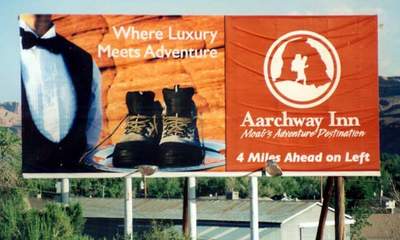
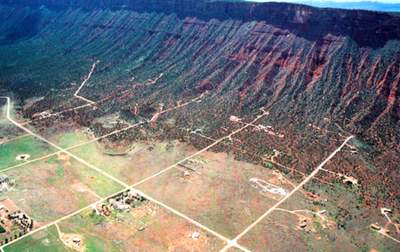
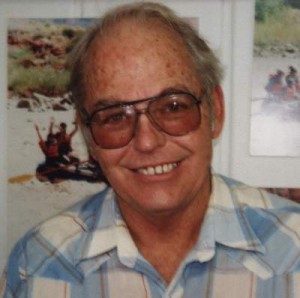
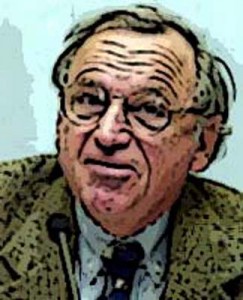
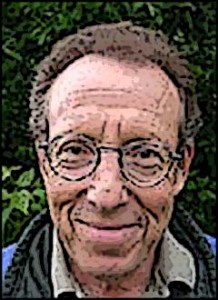
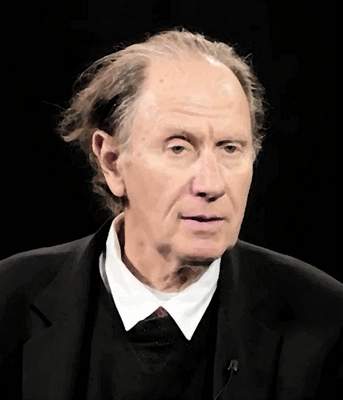
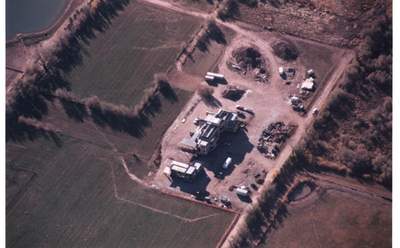
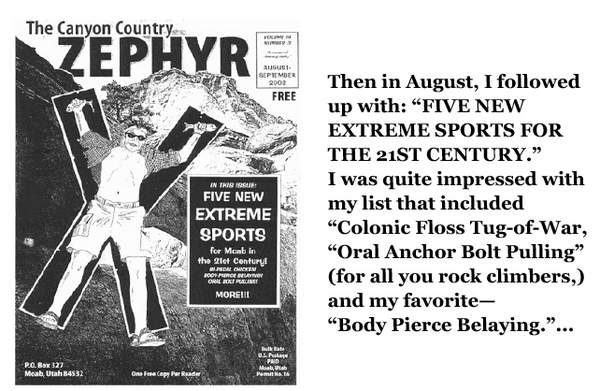
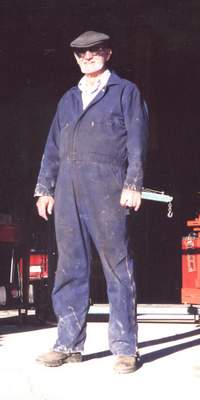
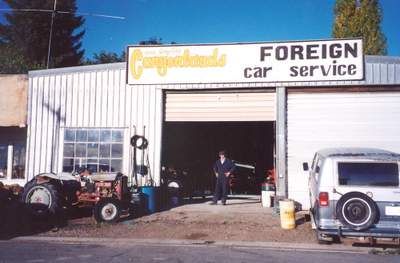
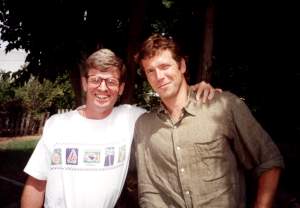

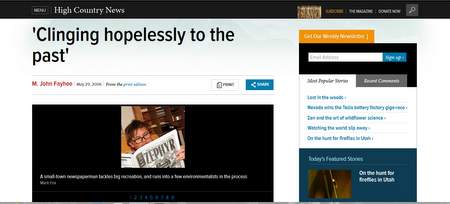
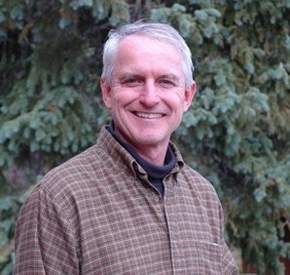
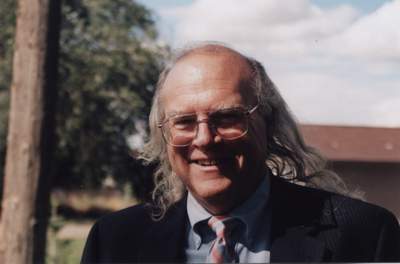
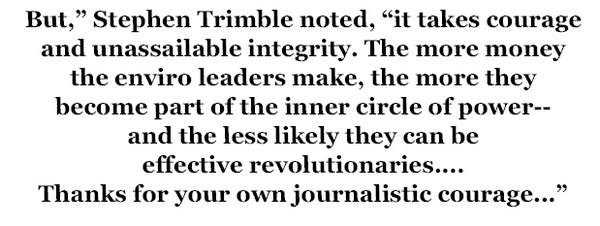

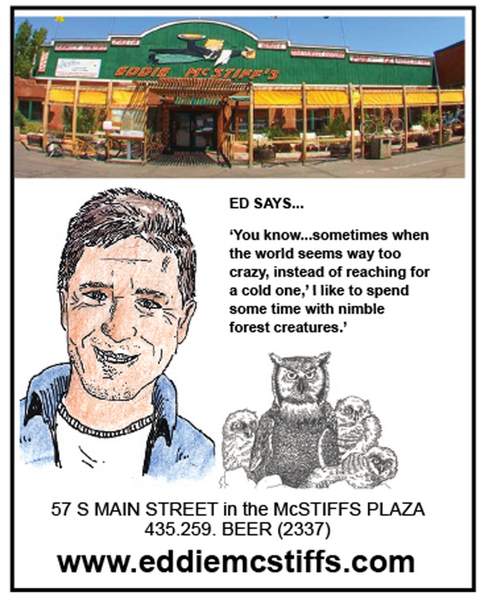
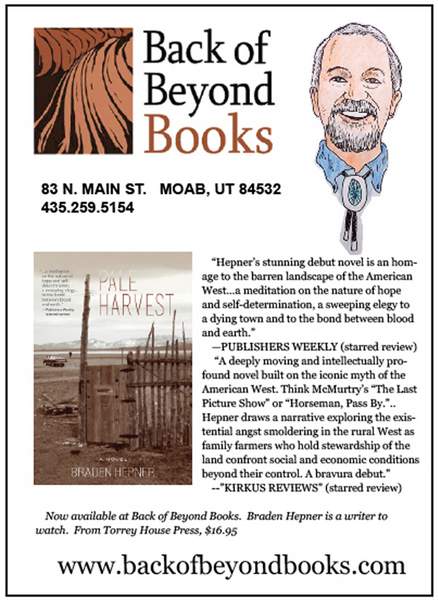

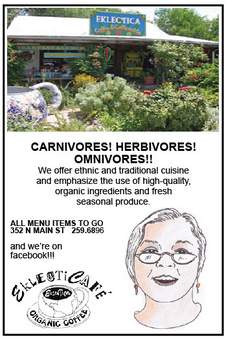

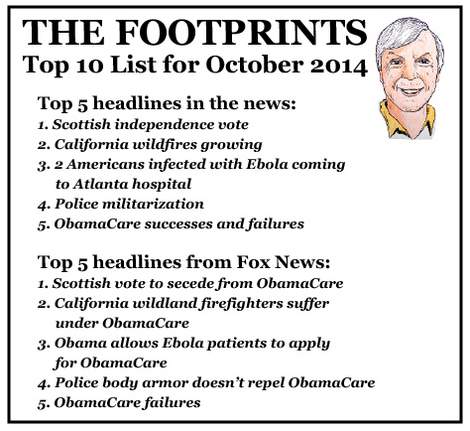

Read with interest your take on the new environmental “allies.” Had the pleasure to meet with the former GCT leader Phil Pearl, and felt the organization was not valid to support. I did hear a similar criticism of myself as was leveled at you, for warning of overpopulation and overconsumption. Those concerns were said to be counterproductive to progress. I must just be slow-witted perhaps. I am holding to my views. I am curious how he separated from the GCT.